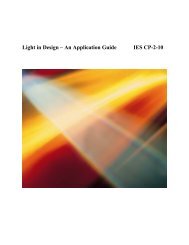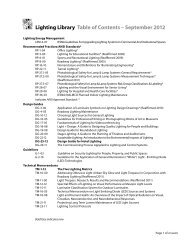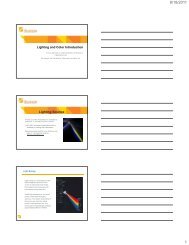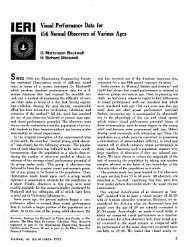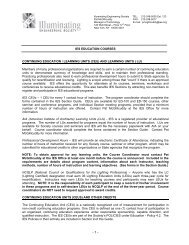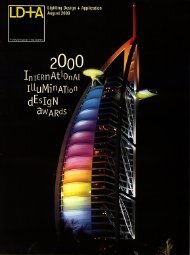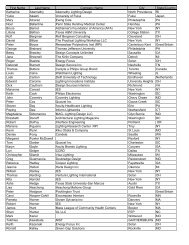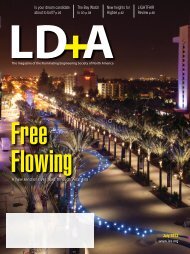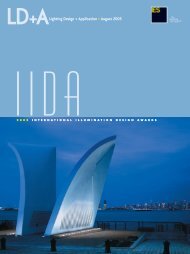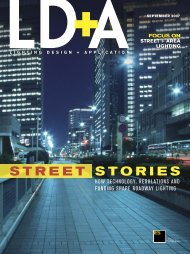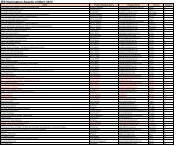An Optional Method For Adjusting the Recommended Illuminance ...
An Optional Method For Adjusting the Recommended Illuminance ...
An Optional Method For Adjusting the Recommended Illuminance ...
You also want an ePaper? Increase the reach of your titles
YUMPU automatically turns print PDFs into web optimized ePapers that Google loves.
PS-6-13<br />
Illuminating Engineering Society of<br />
North America<br />
120 Wall Street, 17th Floor<br />
New York, NY 10005-4001<br />
T 212-248-5000<br />
F 212-248-5017, 18<br />
www.ies.org<br />
<strong>An</strong> <strong>Optional</strong> <strong>Method</strong> <strong>For</strong> <strong>Adjusting</strong> <strong>the</strong> <strong>Recommended</strong> <strong>Illuminance</strong><br />
for Visually Demanding Tasks Within IES <strong>Illuminance</strong><br />
Categories P through Y Based on Light Source Spectrum<br />
The Illumination Engineering Society (IES) is a collegial community dedicated to improving <strong>the</strong><br />
lighted environment, and <strong>the</strong> quantification of <strong>the</strong> effects of lighting on human vision is a fundamental<br />
element of <strong>the</strong> Society’s purpose. The development and documentation of <strong>the</strong> consensus-based illuminance<br />
selection criteria is a key element of <strong>the</strong> IES’ role in guiding and supporting global efforts<br />
to provide quality luminous environments.<br />
Illuminating engineering metrics are based on assumptions related to <strong>the</strong> human eye response<br />
to a light source’s spectral characteristics using <strong>the</strong> photopic luminous efficiency function. In addition,<br />
<strong>the</strong> Spectral Power Distribution (SPD) of a specific light source is known to affect pupil size,<br />
visual acuity, and visual efficiency. Various bodies of research have defined conditions where a light<br />
source’s spectral characteristics can result in variations in visual acuity and pupil response relative to<br />
those predicted by <strong>the</strong> photopic luminous efficiency function.<br />
This Position Statement provides guidance from <strong>the</strong> Society’s Board of Directors to establish a<br />
framework under which TM-24 should be used and <strong>the</strong> application of TM-24 in luminous environments<br />
and <strong>the</strong> lighting design process. TM-24 as a Technical Memorandum is merely a vehicle to<br />
disseminate a focused topic of technical information, which could have an impact on lighting product<br />
designs and/or applications per <strong>the</strong> limited scope of TM-24. TM-24 is not a Design Guide or<br />
<strong>Recommended</strong> Practice, and should not be used as such.<br />
When applying <strong>the</strong> concepts in TM-24, it is crucial to fully understand <strong>the</strong> scope for its appropriate<br />
use. The Equivalent Visual Efficiency (EVE) calculation, introduced within <strong>the</strong> TM-24 document<br />
to account for a light source’s spectrum, applies only to applications for visually demanding<br />
tasks performed in interior lighting conditions where <strong>the</strong> recommended illuminance target is for<br />
categories P through Y. The light distribution should be uniform and <strong>the</strong> luminance of <strong>the</strong> task background<br />
is greater than 50 cd/m2. It also applies only to visual tasks performed under conditions of a<br />
full field of view.
Applications where <strong>the</strong> visual field of view is constricted and/or where <strong>the</strong>re will likely be occupants<br />
with abnormal vision or poor ocular health compared to <strong>the</strong> general population may result in<br />
conditions in which <strong>the</strong> spectral effects of lighting on visual acuity differ from <strong>the</strong> factors described<br />
in TM-24. In addition, design considerations such as visual contrast, color quality, lighting for aes<strong>the</strong>tic<br />
effects as well as integration of lighting with architecture and finishes may be essential to <strong>the</strong><br />
overall lighting design strategy.<br />
The conditions upon which <strong>the</strong> TM-24 findings were developed, include five critical control measures.<br />
The control measures are:<br />
1) full field of view; 2) adaptation; 3) light level/spectral comparison; 4) visual acuity test and<br />
5) fixed distance to task. While <strong>the</strong>se control measures are crucial to <strong>the</strong> evaluation of spectral content<br />
and visual performance, <strong>the</strong>se characteristics may not be easily controlled in applications with<br />
dynamic tasks or where occupants are known to differ in <strong>the</strong>ir ocular health from <strong>the</strong> general population.<br />
The conclusion presented within TM-24 represents <strong>the</strong> view point of The Visual Effects of<br />
Lamp Spectral Distribution committee on this topic. On-going research may offer additional insights<br />
regarding spectral content and visual performance.<br />
TM-24 is not an official IES recommendation or practice, but ra<strong>the</strong>r an optional calculation method<br />
for very specific light level conditions only. This does not inherently translate into energy savings<br />
or reduced lighting power densities. TM-24 should not be used for <strong>the</strong> development of energy policy<br />
or energy efficiency programs purposes for any lighting applications, as this goes against current<br />
IES recommendations. TM-24 and this Position Statement supersede any references, ei<strong>the</strong>r printed<br />
or verbal, that state o<strong>the</strong>rwise.<br />
ABOUT THE ILLUMINATING ENGINEERING SOCIETY<br />
The IES is a collegial community dedicated to improving <strong>the</strong> lighted environment. The IES is<br />
composed of a diverse membership, all with an interest in and a dedication to good lighting. 25% of<br />
<strong>the</strong> membership is involved in manufacturing (lamps, sources, luminaires, accessories); ano<strong>the</strong>r 25% is<br />
composed of lighting designers and architects. The remaining 50% is composed of consultants, electrical<br />
and building contractors, distributors, and wholesalers, individuals working in affiliated lighting<br />
fields, those working for utilities and energy services, and people in government and education. Over one<br />
thousands of <strong>the</strong>se individuals serve on committees, most serving on <strong>the</strong> Society’s document development<br />
committees; <strong>the</strong>se committees develop standards, design guides, technical memoranda, lighting<br />
energy management materials, guidelines and lighting measurement, testing and calculation guides.<br />
Illuminating Engineering Society<br />
of North America<br />
120 Wall Street, 17th Floor<br />
New York, NY 10005-4001<br />
Phone: 212-248-5000; Fax: 212-248-5017<br />
www.ies.org<br />
###



